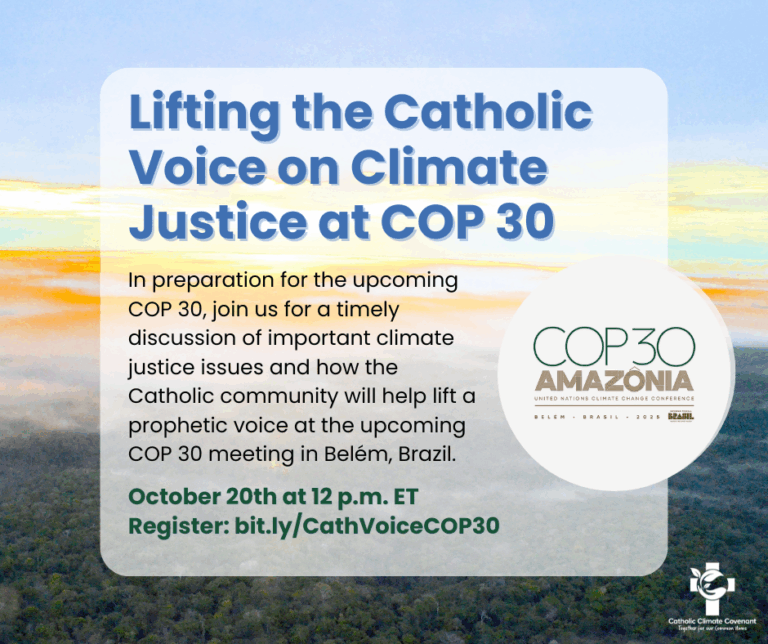I’ve recently begun working as an Intern for Youth and Young Adult Mobilization with Catholic Climate Covenant, something I’m not surprised by since Saint Francis and I go way back. I chose him as my patron saint for Confirmation and then proceeded to spend 12 years of my young adult life with a community of Franciscan women. What does surprise me, however, is just how long I had missed the huge connection between ecology and spirituality.
Fortunately, my team at Catholic Climate Covenant is patient with my learning. They see my growing understanding as an asset and have begun connecting me with individuals and resources that can help me bridge the gap.
In the midst of all these connections, I was presented with the opportunity to reflect on fast fashion after this blog post from Porch.com came across my desk. “Is this a topic you might be interested in writing about?” my supervisor asked. Yes, I thought. Super interested. I might be a Franciscan on many levels, but clothing is still a weakness of mine.
Knowing that the holidays spur the thought of shopping for so many, and that Christmas is just a few weeks away, I figure now is as good a time as any to reflect on fast fashion and shopping habits.
I first heard the term “fast fashion” when I watched a documentary about six years ago called, The True Cost. It addressed the negative impact of mainstream fashion on both humanity and the environment and revealed who really pays the price for cheap clothing. (Hint: We all pay a price, but the poorest and most vulnerable among us pay the highest price). My shopping habits were never the same after that documentary, but I knew I couldn’t keep this newfound knowledge to myself.
Since I was teaching at an all-girls high school at the time, I squeezed the film into my curriculum, somehow tying it into Catholic Vocations or World Religions. We watched it in a single sitting, and when it was over one of my students jokingly—but somewhat seriously—said, “What! We can never not know this now. Why would you do this to us?”
I’ll admit I was happy to have some fellow shoppers left in shock the way I was—it turns out misery really does love company—but I was also happy to know that it would change the way at least some of us viewed our closets and the many worlds that went into filling them.
This many years later, I am still mindful of where and from whom I purchase my clothing. Is all of it vegan, organic, sustainable, locally sourced, small-company owned, thrifted, or certified fair trade? No. Does a lot more of my clothing fall under those categories now than it did before I learned about fast fashion? Absolutely.
Here’s what I’m still working on: bridging the gap. And I’m definitely not talking about Gap, Inc. here, since they still have a long way to go toward providing a living wage for their workers. What I am talking about is the gap that remains for me between ecology and spirituality.
I’ve been doing my best to mindfully purchase clothing and other items, aware that someone on the other side of my purchase is affected, and knowing that I want to leave as small a carbon footprint as I possibly can. Working with Catholic Climate Covenant is helping me see that while this definitely still matters, what matters more is how God fits into the picture.
I love God, and I love who and what God created, but now I’m beginning to understand that caring for creation is not separate from my spiritual life. I get to care for creation, not just because I should, but because it tells me something about the One who created it. Pausing to care for the earth and its people allows room for me to see and hear God in ways I wouldn’t otherwise.
Fast fashion obscures the beauty of God and muffles the crying of the earth by grabbing our attention with low prices and bright colors. When we remember that God made the people and resources on the other side of our products and called them ‘good’, we are brought back to that still small voice within creation. We are called to pause and to look again at the people and resources behind our products so that we can use our purchasing power to acknowledge the goodness of God and work to uphold that goodness. It’s one of the many ways we can bridge the gap.
P.S. If you need a go-to resource for ethical clothing brands and/or if you want to know how some of your favorite brands are doing, Good On You has rated thousands of brands based on their treatment of people, animals, and the planet. For shoppers on a budget, don’t forget that re-gifting some of your favorite items to friends and loved ones, making gifts, or finding unique thrift items is just as fun, meaningful, and sustainable!
If you’re interested in additional resources for learning and shopping, here’s a great starting point:
- CRS has excellent resources to begin the exploration of ethical and fair-trade clothing advocacy. See: How Becoming a Fair-Trade Advocate Led Me Back to Faith and There Is A Life…Behind Our Clothing and The Price of Fashion on Our Planet and 3 Ways You Can Help
- Fast Fashion to Go: A Throwaway Culture That Has to Go to Save the Environment: Includes short readings on sweatshops, fashion and the environment, how the Church has responded to fast fashion.
- Some Back-to-School Clothes Aren’t Good for the Planet. Here’s a Better Option
- Fast Fashion: Good for Business, Bad for the Planet. What Can You Do?
- Eco-chic: Clothing with Conscience, The Arlington Catholic Herald.

